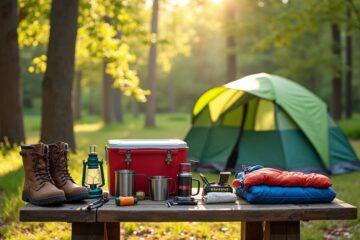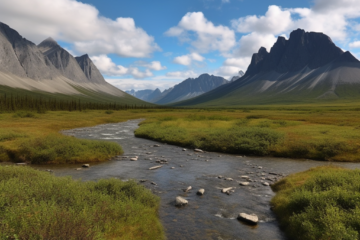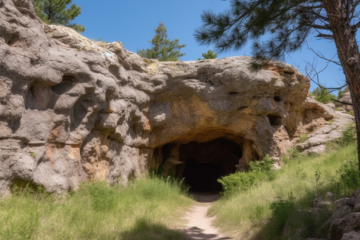With its stunning desert landscapes, wind-carved canyons, and some of the darkest skies in the United States, Death Valley National Park is a must-visit destination for any outdoor enthusiast.
The park’s incredible landscape draws hundreds of thousands of visitors every year who come to experience the beauty and serenity that only the desert can provide. For those more adventurous souls however, camping at Death Valley National Park offers an even deeper connection with this magnificent place.
This blog post will provide you with all the necessary information about camping at this awe-inspiring location including what climate to expect, which campsites are best suited for your needs; how to prepare for extreme weather conditions; safety tips and advice; as well as recommendations on things to see and do while visiting Death Valley National Park.
1. Understand the Climate
Death Valley National Park is an arid desert located in the Mojave Desert, and is known for its scorching hot weather. It is important to be aware of the climate before you plan a camping trip there.
The temperature in summer months can reach up to 120°F (49°C) during the day and drop down to 90°F (32°C) at night. During winters, temperatures may range from 50-70 °F (10-21 °C). The rainfall is usually low and averages around 2 inches annually, so it’s important to take enough water with you when going for camping.
It’s also worth noting that due to the extreme heat, most outdoor activities are best done early in morning or late evening when temperatures are more bearable. For instance, if you would like to go hiking or backpacking, plan your activities between 6am-9am or 5pm-7pm. These are also the times when wildlife tend to come out into open areas making them ideal times for exploration as well.
Additionally, due to its location in a mountain valley surrounded by mountains on all sides, wind patterns may cause dust storms which can significantly reduce visibility on some days while bringing cooler air with them too depending on direction of wind flow from nearby mountain tops. Hence it’s always better if you check forecasted weather conditions before planning a trip here as this information will help inform decisions about what gear/resources need packing ahead of time!
2. Choose the Right Campsite
Death Valley National Park has three campgrounds: the Furnace Creek Campground, Stovepipe Wells Campground and Texas Spring Campground. Each campground has different amenities, so you’ll need to decide which one would suit your needs best.
At the Furnace Creek Campground, there are 134 individual sites with tables and fire pits. There is also a shower house available for camper use. This campground is open year-round and reservations can be made in advance.
The Stovepipe Wells Campground offers plenty of space for tents or RVs with electric hookups as well as flush toilets and showers. There are no reservations accepted here, however visitors will need to pay a fee upon arrival at the camp entrance station before setting up their campsite. The camping season typically runs from October through May each year here.
Finally, there is the Texas Spring Campground which offers paved RV parking pads as well as some primitive tent camping options on a first come first served basis only – no reservations accepted here either! Guests will have access to dump stations but not showers or electricity at this location.
It’s important to note that all three of these campgrounds do fill up quickly during peak seasons such as springtime when temperatures tend to be milder than other times of year, so plan ahead if possible
Furnace Creek Campground
Furnace Creek Campground is one of the most popular camping spots in Death Valley National Park. This campground offers a variety of sites that can accommodate tents, RVs, and car campers. The campsites are nicely spaced out and have easy access to toilets and showers.
The climate at Furnace Creek Campground is hot during the day (average high temperatures reach over 100 degrees Fahrenheit) but much cooler at night (average low temperatures dip into the mid-50s). It’s best to plan your activities around these temperature extremes, as the peak heat can be quite intense.
When choosing a campsite at this campground, you’ll want to pick one with some shade for relief from the sun or wind protection if it’s breezy outside. You’ll also want to consider whether you’d like an RV spot or one that’s just for tent camping, as they do have separate areas for each type of camper.
It is important that you understand what type of vehicle restrictions apply in certain areas as not all vehicles are allowed on certain roads or trails within Death Valley National Park. Make sure to check with park staff before planning your trip so there aren’t any surprises!
Stovepipe Wells Campground
Stovepipe Wells Campground is the most popular campground in Death Valley National Park. The site has over 100 campsites, eight group sites, and two RV-only pull-through sites. It’s located near Stovepipe Wells Village and offers easy access to amenities like a general store, restaurant, gas station, and motel.
The campground offers great views of nearby mountains and desert landscapes. It’s also close to some of the area’s top attractions such as Mosaic Canyon and Natural Bridge Trailhead — both must-see features of Death Valley National Park!
The campground has flush toilets, potable water sources (though it’s recommended you bring your own water), fire pits with grills (firewood must be purchased at a local store), bear boxes for food storage, trash cans, as well as picnic tables where you can enjoy meals in the great outdoors.
Each site comes with its own parking spot plus space for one tent or RV — depending on the size of your vehicle. Some sites are also pet friendly so make sure to ask about that when booking a reservation online or by phone. Just remember that pets must remain on leashes while camping at Stovepipe Wells Campground!
Texas Spring Campground
Texas Spring Campground is located at the lower end of Death Valley National Park, close to the Furnace Creek Visitor Center and Museum. It offers visitors a chance to relax in one of nature’s most extreme environments.
The campground features RV and tent camping sites, as well as group campsites. Each site comes with a picnic table and fire pit. There are also bathrooms nearby, with flush toilets and running water available.
Texas Spring has some unique amenities that make it ideal for outdoor adventurers looking for an off-the-beaten-path experience such as temperatures rarely exceed 100 degrees Fahrenheit during the summer months, and there is plenty of hiking available near the campground.
It’s important to note that due to its remote location, services such as gas stations or restaurants may be difficult to access while staying here – so plan accordingly! Be sure to bring plenty of food supplies before embarking on your trip.
3. Prepare for the Weather
Death Valley National Park is an extremely hot and dry place, with temperatures routinely reaching well into the triple digits. It’s important to be prepared for the heat and make sure that you have enough water when camping in this area.
Here are some tips on how to prepare for the weather:
Pack plenty of water – aim for at least one gallon per person, per day.
Wear lightweight, loose clothing to keep your body cool. Make sure it covers your skin from the sun as much as possible. Hats and sunglasses can also help protect you from harmful UV rays.
Bring sunscreen with an SPF of 30 or higher and apply it regularly throughout your trip.
Bring a wide brimmed hat or umbrella to provide shade during peak hours of sunlight (10am – 4pm).
Avoid strenuous activities such as hiking during the hottest parts of the day (10am – 4pm). Try planning outdoor activities before 10 am or after 4 pm when possible.
If you do become too hot while out in nature, find a shady spot and rest until your body temperature returns to normal levels before continuing on your journey.
4. Safety Tips
When camping out in the desert, safety should always be your top priority. Here are a few important tips to keep in mind when camping at Death Valley National Park:
Bring plenty of water with you as dehydration is a real danger. Make sure that you drink plenty of fluids during your trip and stay hydrated while adventuring around the park.
Wear appropriate clothing, such as light colors and breathable fabrics. Loose fitting clothing will also help to protect against sunburn and heat exhaustion.
Be aware of wildlife that may inhabit the area, including snakes, scorpions, cougars and bears. Do not approach any wild animal or try to feed them for any reason!
Always wear sunscreen and keep yourself covered up when possible to avoid sunburns or other skin damage due to prolonged exposure in direct sunlight.
Ensure that campfires have been extinguished before leaving the campsite. Wildfire is a serious risk in desert environments so take extra precautions when starting fires near dry vegetation.
Be mindful of your surroundings at all times – watch out for loose rocks on trails or uneven terrain that can cause an accident if you’re not careful!
5. Things to See and Do
Death Valley National Park is a great spot for camping, with plenty of sites available to choose from. Furnace Creek Campground is the largest in the park and offers over 100 sites. It features flush toilets, showers, and RV hookups. Stovepipe Wells Campground has 88 sites and does not have any amenities other than restrooms, while Texas Spring Campground offers 58 primitive campsites with no water or electricity.
Regardless of which campground you choose to stay at, it’s important to be prepared for the weather conditions in Death Valley National Park. The summer months can be scorching hot during the day, so make sure that you bring along plenty of water and proper sun protection gear such as hats and sunscreen. At night though temperatures can drop significantly so pack accordingly with warm clothes for evenings around the fire pit or under the stars.
In terms of safety tips when camping in Death Valley National Park, it’s important to practice Leave No Trace principles and keep your campsite clean and tidy throughout your stay. Don’t forget to bring a first aid kit should any injuries occur during your visit too!
From exploring Wildrose Charcoal Kilns (a series of nine kilns built by local miners) to taking a stroll through Mesquite Dunes (an expansive area of sand dunes), there are plenty of things to see and do at Death Valley National Park that will complete your camping experience! Another must-see destination is Badwater Basin – the lowest point in North America located 282 feet below sea level – which makes for an unforgettable photo opportunity!.
Wildrose Charcoal Kilns
The Wildrose Charcoal Kilns are one of the most iconic sights in Death Valley National Park. Located on the western edge of the valley floor, these beautifully preserved kilns were constructed in 1876 to produce charcoal from piñon and juniper trees for smelting ore at nearby mining sites.
The kilns have since been restored and are now open to visitors year-round. Visitors can explore the area around the kilns, take photos, learn about their history, and even see some of the remaining pine trees that were used to fire them up back in their heyday.
Wildrose Charcoal Kilns also serve as a great starting point for exploring other parts of Death Valley National Park. Nearby attractions include Mosaic Canyon, Teakettle Junction, and Badwater Basin—all within an easy drive from the kilns.
If you’re looking for a unique experience while camping at Death Valley National Park, visiting the Wildrose Charcoal Kilns is definitely one not to be missed!
Mesquite Dunes
The Mesquite Dunes are a must-see for anyone camping at Death Valley National Park. Located in the park’s remote northern section, these dunes are some of the tallest sand dunes in North America and offer stunning views of the valley below.
The area is also home to many species of wildlife, including snakes, lizards, and birds. When visiting these dunes, be sure to wear appropriate clothing and footwear as the sand can become very hot during summer months. It’s also recommended that you bring plenty of water so that you don’t get dehydrated while exploring this unique landscape.
If you’re feeling adventurous, try hiking up one of the massive sand dunes for an even better view! Be aware that this is an arduous task due to the soft sand and steep slopes so make sure to take your time and plan ahead if attempting such a feat.
When heading out into nature it’s important to remember Leave No Trace principles–take any trash with you when leaving and respect all animals in their natural habitat by not disturbing them or taking anything from them without permission.
Badwater Basin
Badwater Basin is located in Death Valley National Park and it’s the lowest point in North America, at 282 feet below sea level. This iconic basin is an incredible sight to behold and a must-see for visitors of the park.
Though water does not usually reach the surface of Badwater Basin, there are times when storms can cause flooding that will fill the basin with up to nine feet of water for several days. When this happens, it creates an otherworldly landscape with reflections of distant mountains mirrored on its still waters.
The salt flats here are also quite unique – they are composed of multiple layers that change color depending on how much sunlight reflects off them. The area around Badwater Basin also offers some great hiking opportunities as well as stunning views of nearby mountain ranges like Telescope Peak and Wildrose Peak.
Badwater Basin offers something for everyone – whether you’re looking for a scenic view or some adventure, this spot has it all!
6. Conclusion
Camping in Death Valley National Park is a unique and rewarding experience, but it also requires preparation to ensure your safety. Make sure you understand the climate of the area and select the right campsite for your needs. Prepare for any weather that may come your way and keep in mind essential safety tips when exploring Death Valley’s vast landscapes. With so much to see and do, from Wildrose Charcoal Kilns to Badwater Basin, there is always something new to experience in this incredible national park.


